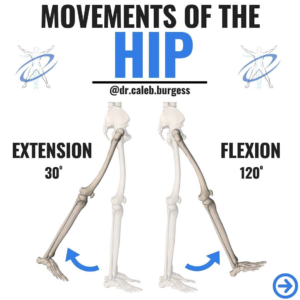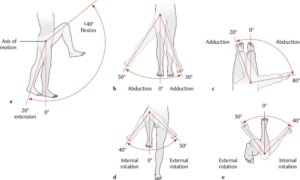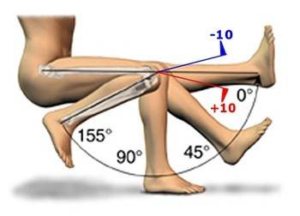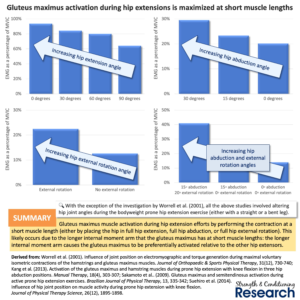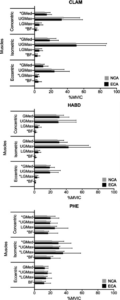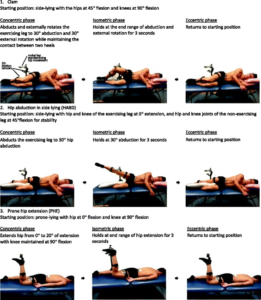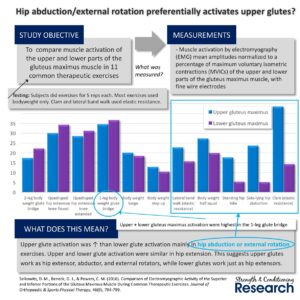HIP EXTENSION with KNEE FLEXED – RESEARCH
Click on Image to Enlarge
MOVEMENTS at the HIP and the KNEE
STRETCH ILIOPSOAS before HIP EXTENSION with KNEE FLEXED
GLUTEUS MAXIMUS, BICEPS FEMORIS, ERECTOR SPINAE, MULTIFIDUS
– Prone Hip Extension with Knee Flexed @90º
LEG at multiple degrees of KNEE FLEXION
GLUTEUS MAXIMUS, HAMSTRINGS
– Prone Hip Extension with Knee Flexed 90º + Hip Ab-ducted 0°, 15°, and 30°.
Activation of gluteus maximus and hamstring during prone hip extension with knee flexion in 3 hip ab-duction positions – 2013 – Kang
Procedure
– The direction of fiber alignment within a muscle is known to influence the effectiveness of muscle contraction
– prone on examining table with knee flexed at 90º in 3 hip ab-duction positions: 0°, 15°, and 30°.
Electrode Placement
– Gluteus Maximus: halfway between the greater trochanter and second sacral vertebra in the middle of the muscle and at an oblique angle
– Hamstrings: placed parallel to the muscle fibers on the posterior aspect of the thigh, approximately halfway between the gluteal fold and the popliteal fold
Results
Gluteus Maximus: 30° >> 15° > 0°
Hamstrings: 0° > 15° > 30°
1
GLUTEUS MAXIMUS, RECTUS FEMORIS, VASTUS LATERALIS, VASTUS MEDIALIS
– Standing Kickback vs. Leg Press vs. Knee Extension
Electromyographic Comparison of Five Lower-Limb Muscles between Single- and Multi-Joint Exercises among Trained Men – 2021
– Nicolay Stien, Atle Hole Saeterbakken, and Vidar Andersen
Procedure
– 15 resistance-trained men
Exercises
1. Leg Press: starting position 90° knee flexion; 60° hip flexion; extended knee to 180° and hip joints 150°
2. Knee Extension: started at 90° knee flexion; performed to a full extension 180°
3. Kickback: standing; 90° angle in the hip joint; knee semi-extended 170°; concentric 180° in the hip joint
Results
Gluteus Maximus: leg press 90 | kickback 80
Rectus Femoris: knee extension 95 | leg press 70
Vastus Lateralis: leg press 105 | knee extension 90
Vastus Medialis: leg press 95 | knee extension 80
+ Biceps Femoris: kickback 105 | leg press 30
GLUTEUS MAXIMUS UPPER & LOWER, GLUTEUS MEDIUS
– Prone Hip Extension with Knee Flexed @90º
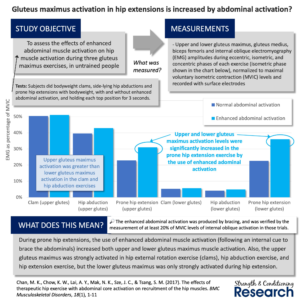 The effects of therapeutic hip exercise with abdominal core activation on recruitment of the hip muscles – 2017 – Chan
The effects of therapeutic hip exercise with abdominal core activation on recruitment of the hip muscles – 2017 – Chan
Procedure
· 2 conditions: Natural Core Activation, Enhanced Core Activation
Results
Clam: hip flexed 45° . knees flexed to 90° . hip abduction 30° . hip external rotation 30°
· upper glute max 40 . glute medius 15 . lower glute max 5
Side-Lying Hip Ab-duction: to 30° with knee fully extended
· upper glute max 30 . glute medius 30 . lower glute max 5
Prone Hip Extension: knee flexed to 90° . hip extension up to 20°
· lower glute max 25 . upper glute max 20 . glute medius 20 . biceps femoris 20
GLUTEUS MAXIMUS
1. Quadruped Kick-up with Knee Flexed @90º
2. Quadruped Hip Extension with Knee Starting @90º Extending to Straight
Which Exercises Target the Gluteal Muscles While Minimizing Activation of the Tensor Fascia Lata? – 2013 – Selkowitz
Procedure
– determine which exercises are best for activating the gluteus medius and the superior portion of the gluteus maximus, while minimizing activity of the tensor fascia lata (TFL).
Fine Wire Electrodes
– SUP-GMAX: superior and lateral to midpoint of a line drawn b/n the posterior superior iliac spine and posterior greater trochanter.
– GMED: inserted 2.5 cm distal to the midpoint of the iliac crest (ie, middle portion).
– TFL: inserted distal and slightly lateral to the anterior superior iliac spine and medial and superior to the greater trochanter.
Exercises
Hip extension in quadruped on elbows with knee flexed: This exercise was performed in the same manner as described for quadruped with knee extending, except that the subject maintained the knee in 90° of flexion throughout the exercise.
Hip extension in quadruped on elbows with knee extending: Starting position was quadruped, with the upper body supported by the elbows and forearms, and the knees and elbows at approximately 90° of flexion. The subject then lifted the tested lower limb up and backward, extending the hip and knee to 0°, and then returned to the starting position.
Results
| Exercise | Tensor Fascia Lata | Gluteus Medius | Superior Gluteus Maximus |
|---|---|---|---|
| Side-lying hip abduction | 32.3 ± 13.1 | 43.5 ± 14.7 (P = .012)† | 23.7 ± 15.3 (P = .033)‡ |
| Bilateral bridge – Hip Thrust | 8.2 ± 7.4 | 15.0 ± 10.5 (P = .011)† | 17.4 ± 11.9 (P = .008)† |
| Clam | 11.4 ± 11.4 | 26.7 ± 18.0 (P = .006)† | 43.6 ± 26.1 (P<.001)† |
| Hip hike | 31.4 ± 14.4 | 37.7 ± 15.1 (P = .196) | 17.7 ± 15.2 (P = .001)‡ |
| Lunge | 21.6 ± 14.5 | 19.3 ± 12.9 (P = .623) | 20.1 ± 11.1 (P = .728) |
| Quadruped hip extension, knee extending | 15.6 ± 9.3 | 27.3 ± 14.9 (P<.002)† | 28.5 ± 16.6 (P<.007)† |
| Quadruped hip extension, knee flexed | 18.7 ± 10.6 | 30.9 ± 15.2 (P = .001)† | 30.1 ± 12.5 (P = .012)† |
| Sidestep | 13.1 ± 7.1 | 30.2 ± 15.7 (P = .002)† | 27.4 ± 16.7 (P = .002)† |
| Squat | 4.6 ± 3.8 | 9.7 ± 7.3 (P = .017)† | 12.9 ± 7.9 (P<.001)† |
| Step-up | 21.4 ± 11.4 | 29.5 ± 14.9 (P = .065) | 22.8 ± 15.6 (P = .754) |
| Unilateral bridge – Hip Thrust | 18.1 ± 12.9 | 30.9 ± 20.7 (P = .007)† | 34.6 ± 16.8 (P = .001)† |
